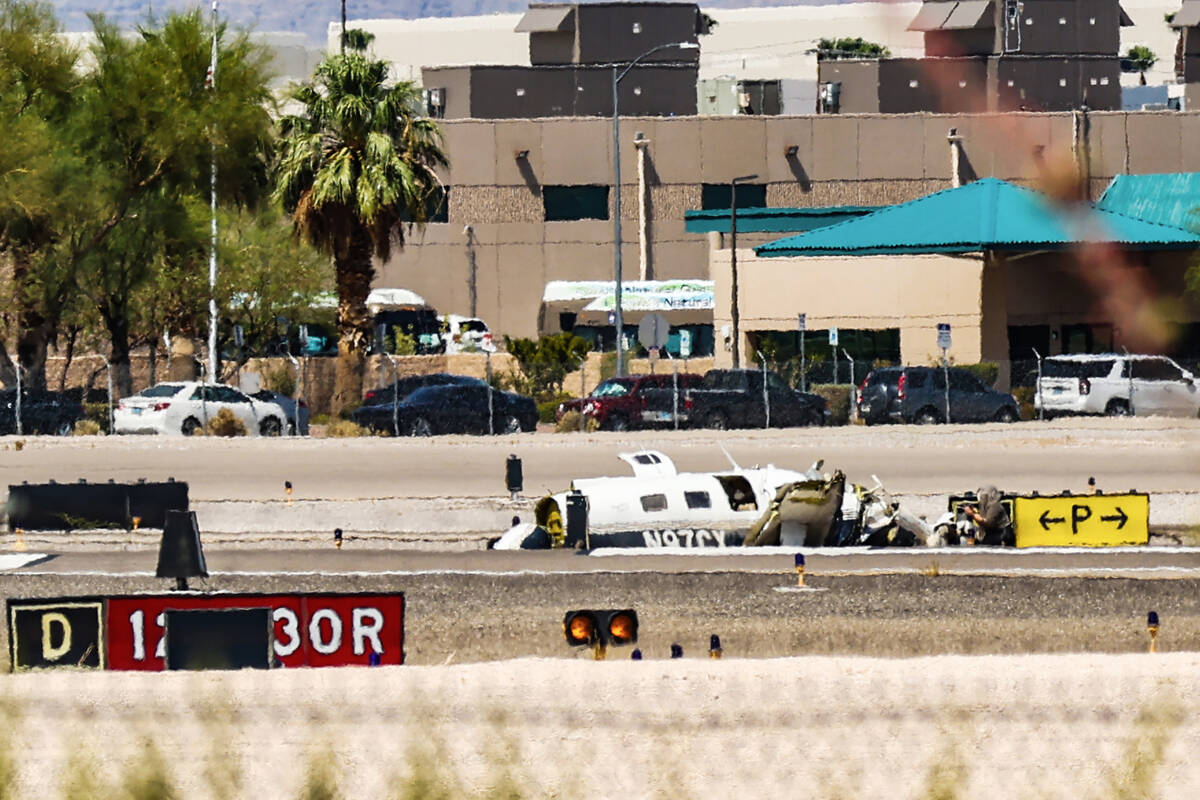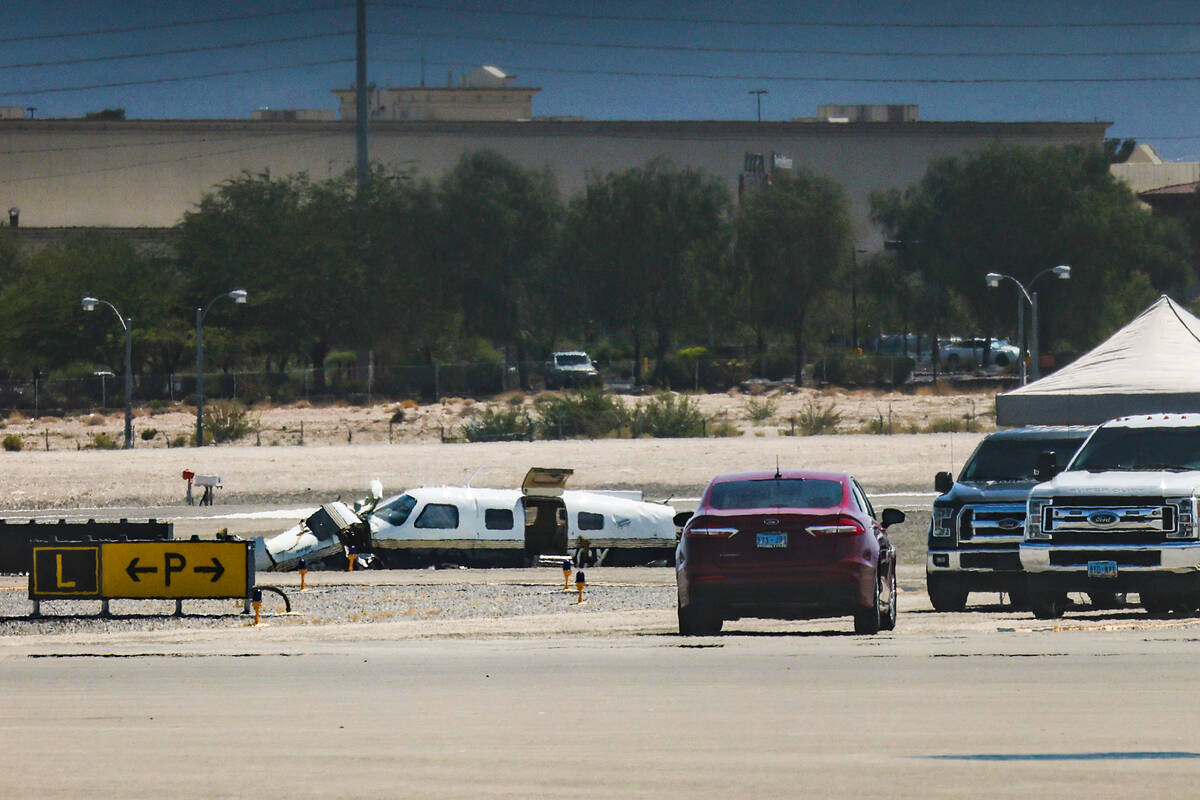Pilot in deadly NLV airport crash likely flew toward wrong runway
A midair collision between two airplanes July 17 at the North Las Vegas Airport appears to have been caused by a pilot lining up to land on the wrong runway, an aviation nonprofit said this week.
The National Transportation Safety Board said the crash, which killed four people, unfolded when a Piper PA-46 Malibu and a Cessna 172 collided at noon as both aircraft were approaching parallel runways, named 30L and 30R.
Richard McSpadden, a senior vice president at the nonprofit Aircraft Owners and Pilots Association, said this week an early analysis of aircraft tracking data and air traffic control recordings from the crash indicate the pilot of the Piper was about to land on the 30R runway even though the pilot was instructed by an air traffic controller to land on 30L.
“There is clear transmission between the tower and the Malibu twice that the clearance is on the left runway,” McSpadden said.
The occupants of the Piper, Donald Goldberg, 82, and Carol Scanlon, 76, both of Las Vegas, were killed. It is not clear who was flying the plane.
Also killed were the occupants of the Cessna, flight student Zach Rainey, 47, and a flight instructor whose name has not been released by the Clark County coroner’s office.
McSpadden oversees the association’s Air Safety Institute, which detailed its preliminary analysis of the crash in a video. McSpadden said the information detailing the flight paths of the two planes is preliminary and is aimed at benefiting pilots as part of a larger discussion about safety. The nonprofit’s analysis is also not meant to replace or mitigate a comprehensive federal investigation that is underway, McSpadden said.
‘Uncalled-for communication’
In a phone interview Wednesday, McSpadden said publicly available recordings between an air traffic controller and Scanlon in the Piper show that as the plane was approaching the airport, Scanlon tells the controller about the Piper’s descent for preparation to land when a person, presumably another pilot, briefly jumps in on the air traffic control channel conversation.
The unidentified man attempts to start a casual conversation with Scanlon as the Piper approaches the airfield.
“North Las Vegas Tower N97cx descending out of 7,000 feet for landing on 30L, and uh, now we’re set to cross mid-field,” Scanlon is heard telling the air traffic controller when the man’s voice interjects.
“Hello, Carol,” the man says.
“Hi!” Scanlon responds.
“Where you going? Where you coming from?” the man asks Scanlon.
McSpadden said the unidentified man heard in the recording is likely another pilot in the area. Such an interjection, McSpadden said, was ill-advised.
“Every pilot who heard that cringed,” McSpadden said. “It’s uncalled for communication. It is unprofessional. And, it may even be problematic from a rules standpoint.
“There are two things wrong with it. You just don’t engage in any type of extraneous chatter like that on a formal frequency like a tower frequency. You don’t distract a pilot when they are coming in to land in the most critical phase of flight. … It was out of line, it was out of place, and at the very least it was a distraction.”
The recordings also show that an air traffic controller confirmed with Scanlon twice in the conversations that the Piper was approved to land on the left runway before the aircraft took a sweeping left turn for a landing on the right runway.
“Yep, 30L, that’s what I heard,” Scanlon is heard saying to the air traffic controller moments before the crash.
Parallel runway ‘confusion’
Las Vegas resident and flight instructor Will Bradley, 54, has 15,500 hours of flight experience and has been a licensed flight instructor for 30 years. He said the early analysis of the crash affirms his belief that the parallel, staggered runways with similar names present a safety hazard.
”There’s so much confusion with the parallel runways at this airport. It is time to renumber them,” Bradley said.
Bradley said just before the COVID-19 pandemic started, he attended a Federal Aviation Administration safety meeting at the North Las Vegas Airport. At the time, he said, he voiced concerns to federal officials that the name of one of the runways should be changed.
“In the name of safety I would sacrifice the numbers being off by 5 to 10 degrees on the compass heading for less confusion on which runway you are landing on,” Bradley said.
He also said two planes, headed in the same direction, should never be allowed to land at the same time on parallel runways at an airport like in North Las Vegas. He said the issue is more problematic in North Las Vegas given the significant amount of traffic at the facility, calling the airfield the most “complex airport in the country to learn to fly that I have experienced.”
The FAA sent the Las Vegas Review-Journal an emailed statement on the issue Wednesday.
“The NTSB is in charge of the investigation and the FAA is a party to it,” the FAA said. “In all accident investigations, the FAA looks at nine specific factors, including airport certification safety standards and operations.
“Runways are numbered according to their compass heading, and many airports have parallel runways with the same numbers designated Left and Right. Examples include Henderson Executive airport (Runways 17-35L/R; Deer Valley Airport (Runways 7-25L/R) and Long Beach Airport (Runways 8-26L/R).”
The FAA also said the number of annual flights at the North Las Vegas Airport have dropped and are significantly lower than the number of flights at the facility in the early 2000s. In 2000, there were 225,205 flights at the airport. By 2019 the number was 193,214, and last year the number was 162,624.
Chris Jones, spokesman for the Clark County Department of Aviation, said in an emailed statement that runway nomenclature is directed by the FAA and by compass headings.
“Each of the world’s 10 busiest airports in 2021 has parallel runways with L and R designations,” Jones said. “This is regulated, common practice the world over, and trained pilots understand such designations.”
Jones said the FAA-operated tower is the most-regulated standard for air traffic control. In addition to county oversight, the airport is also inspected regularly by the Nevada Department of Transportation’s Aviation Planning Section, which is responsible for helping ensure the state’s general aviation and private airports meet safety requirements.
McSpadden said changing the names of the runways is worth discussing in the interest of safety, although hundreds of thousands of flights have come in and out of the airport over the years without such a tragedy.
“We are looking at those kinds of things to see how we can make these parallel staggered runways not be such a problem,” McSpadden said. “They are the No. 1 cause of wrong-surface events.”
Contact Glenn Puit by email at gpuit@reviewjournal.com. Follow @GlennatRJ on Twitter.





























